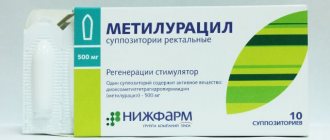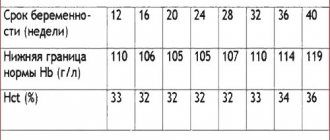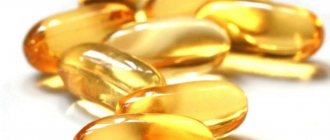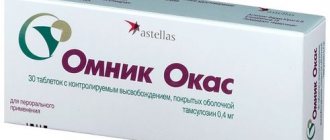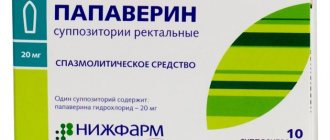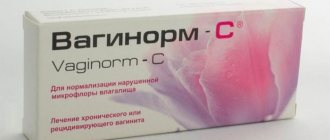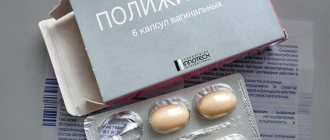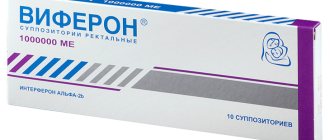White or grayish discharge, itching in the genital area, pain during sexual intercourse or urination - all these factors are signs of thrush (candidiasis). If any of these symptoms appear, you should consult a gynecologist as soon as possible. Hexicon suppositories will help cure the disease. Instructions for use for thrush are given below.
Varieties and composition
The active element of the drug is chlorhexidine bigluconate. The composition of the auxiliary components and the volume of the active substance varies and depends on the form of the product. Pharmacies receive the medicine in the following forms, the content of the active substance in which is:
- Vaginal suppositories (suppositories) – 8 or 16 mg.
- Gel - 0.5 g per 100 g.
- Solution for external use - 20%.
- Vaginal tablets “Hexicon” (which also helps with genitourinary infections) – 16 mg.
The cardboard pack contains 2 blister packs (10 suppositories) and instructions for use of the drug.
Composition of Hexicon candles
The active substance included in Hexicon vaginal suppositories is chlorhexidine bigluconate, auxiliary elements are purified water and polyethylene oxide.
This suppository base, when dissolved in the vagina, creates a “bath” effect, effectively cleansing the mucous membrane of germs, bacteria and pathological secretions. During treatment with Hexicon suppositories, it is recommended to use panty liners, since the leakage of the suppository from the vagina is accompanied by copious watery discharge.
Hexicon candles are white and torpedo-shaped. Produced in blister packaging. The drug is stored in a dry place and protected from light at a temperature not exceeding 25°C. Shelf life: 2 years.
Indications for use
Tablets and suppositories are prescribed to prevent sexually transmitted diseases, treat various etiologies of vaginitis, prevent infections and inflammation in surgery and obstetrics. The medicine "Hexicon" is used:
- for the prevention of syphilis;
- ureaplasmosis;
- chlamydia;
- genital herpes;
- trichomoniasis;
- gonorrhea;
- therapy for vaginal dysbiosis;
- vaginitis;
- when installing and removing the intrauterine device;
- before childbirth;
- operations to terminate pregnancy;
- diathermocoagulation of the cervix;
- intrauterine examinations;
- surgery for gynecological diseases.
Hexicon solution is indicated for use:
- for disinfection of medical equipment;
- treatment of the surgical field and hands of medical workers before surgical interventions;
- for the treatment of infections of mucous membranes and skin in gynecology and obstetrics;
- with urethritis;
- sore throat;
- urethroprostatitis;
- disinfection of purulent wounds and burns that have become infected;
- to prevent sexually transmitted infections.
By
Hexicon or Terzhinan
Both drugs are not analogues of each other. Hexicon is an antiseptic for intravaginal use. Active ingredient: Chlorhexidine. Release form: vaginal suppositories and vaginal tablets. Terzhinan is a combination drug with antimicrobial, anti-inflammatory, antifungal, antiprotozoal action (active components: Ternidazole, Neomycin sulfate, Nystatin, Prednisolone). Indications:
- Treatment of vaginitis caused by sensitive microorganisms, including: bacterial vaginitis; vaginal trichomoniasis; vaginitis caused by fungi of the genus Candida; mixed vaginitis.
- Prevention of urogenital infections/vaginitis, including: before gynecological operations; before childbirth or abortion; before and after installation of the IUD; before and after diathermocoagulation of the cervix; before hysterography.
Hexicon suppositories are indicated during pregnancy and lactation. The use of Terzhinan is possible from the second trimester of pregnancy. The course of treatment with Hexicon is from 7 to 10 days. The minimum duration of treatment with Terzhinan is 6 days, the maximum is 20 days (for example, if mycosis is confirmed). The choice of drug for treatment is determined by the doctor. Hexicon is available without a prescription, Terzhinan is available with a prescription.
The country of origin of Hexicon is Russia. Terzhinan is produced in France. Terzhinan is more expensive than Hexicon. Price per package from 419 rub.
Hexicon or Terzhinan. Photo: moimakiyazh.ru
Instructions for use
Pills
The medicine is used intravaginally. Before administration, Hexicon tablets must be moistened in water. Procedures are carried out up to 2 times a day for a week, maximum 10 days. To prevent sexually transmitted infections, 2 tablets are administered after sexual intercourse, when no more than 2 hours have passed.
Gel
The medicine is applied in a thin layer to the infected areas or applications are made. During the treatment of vulvitis and balanoposthitis, the affected organs are treated with medication twice a day for a week. In dental practice, for periodontitis, gingivitis and other infections, Hexicon gel is used 2-3 times a day. To do this, apply applications with exposure for 3 minutes.
Suppositories "Hexicon"
Suppositories are used intravaginally twice a day. The course of treatment is up to 7 - 10 days. To prevent infections, it is enough to administer 1 suppository in the first 2 hours after sexual intercourse.
Hexicon during menstruation
The instructions for the drug indicate not to use Hexicon suppositories during menstruation, since the blood that is released during menstruation will dissolve the suppositories and facilitate their rapid removal from the body. This will affect the effectiveness of treatment, since the effect of the drug will be incomplete.
Thus, the use of Hexicon is contraindicated during menstrual bleeding. Treatment with suppositories must be started either 10 days before or immediately after the end of menstruation.
Solution
The drug is used externally or locally, performing rinsing, irrigation or applications. To do this, apply up to 10 ml of the product to the affected areas. The Hexicon solution applied to a cotton swab is applied to the skin or mucous membranes for three minutes. The procedure is performed 2-3 times a day.
To treat urethritis, a solution is injected into the urethra; for infections of the oral cavity, rinses are performed. To prevent sexually transmitted pathologies, the drug is administered to men and women within the first 2 hours after sexual intercourse.
By
Hexicon or Betadine
The drugs are not analogues of each other. The active ingredient of Hexicon is Chlorhexidine. Form of release: vaginal suppositories, vaginal tablets. The drug is indicated during pregnancy, lactation and in pediatric gynecology (from 6 months). You also need to know that the dosage form of vaginal tablets Hexicon does not increase the amount of vaginal discharge when used. Betadine is an antiseptic that contains Povidone-Iodine. Release form: ointment, solution, vaginal suppositories.
The drugs are approved for pediatric use. Betadine suppositories can be used for children from 8 years of age, and Hexicon at a dosage of 8 mg (Hexicon D) is indicated from 6 months. Pregnant and lactating women should be prescribed Betadine with caution. Hexicon suppositories are indicated during pregnancy and lactation. Both drugs are available without a doctor's prescription. The choice is made by a specialist. The drugs are indicated for the prevention of sexually transmitted infections (use no later than 2 hours after unprotected sexual intercourse).
The country of origin of Betadine is Hungary. Hexicon is produced by Russia. Hexicon is more expensive than Betadine.
Hexicon or Betadine. Photo: betadin.ru
Side effects
In general, Hexicon is a safe medication that causes negative reactions in the body in rare cases. Most often, troubles can be associated with the use of suppositories. Side effects such as burning and itching in the vagina, as well as allergic symptoms disappear after completion of therapy.
The solution (rarely) may cause sticky or dry hands, photosensitivity or dermatitis. When rinsing the mouth with a solution or gel applications, taste perception may be temporarily disrupted and tooth enamel may be stained.
Contraindications
The only prohibition for using suppositories is the presence of individual intolerance. Side effects manifest themselves in the form of itching and allergic rashes, which disappear after discontinuation of the medication.
The drug is considered relatively safe, but in some cases, during its use, vaginal discharge containing blood may be observed. This feature indicates that the pregnant woman has an allergy to the drug or other contraindications.
Changing the dose and frequency of use of Hexicon may lead to similar reactions. Also, if a pregnant woman has an increased level of leukocytes in the blood, then the appearance of pale pink or brown vaginal secretion is normal.
Discharge in a pregnant woman when using Hexicon often means the presence of bacterial vaginosis or indicates placental abruption. That is why you should immediately report this condition to your doctor.
Despite the fact that the drug fights thrush, sometimes it causes its development. In this case, you need to consult a doctor to select adequate treatment.
Patient opinions
There are many reviews about the drug "Hexicon" - both positive and negative. Women note the speed of action of the drug, its effectiveness, ease of use, safety, lack of allergies and gentleness of action. It is important that Hexicon suppositories can be used during pregnancy. Doctors confirm the safety and effectiveness of the drug, which cannot be replaced by anything in the early stages.
Negative reviews are associated with the leakage of the suppository and the associated inconveniences after use. Some patients say that after inserting the suppository they experienced burning, itching, and bleeding. In such situations, you need to contact a specialist.
Purpose of Hexicon candles
Hexicon is active against : Gardnerella vaginalis, Chlamydia spp, Ureaplasma spp, Trichomonas vaginalis, Bacteroides fragilis, Neisseria gonorrhoeae, Treponema pallidum. Some strains of Proteus spp, Pseudomonas spp are weakly sensitive to the drug.
Viruses, fungi, bacterial spores and acid-fast bacteria are not sensitive to Hexicon. Therefore, Hexicon is not prescribed for thrush. Suppositories retain some activity in the presence of pus and blood. Almost not absorbed from the gastrointestinal tract. Only 1% is excreted by the kidneys; the main part of the drug is excreted from the body with feces.
Features of the use of Isoconazole against fungal skin diseases
16.08.2017
Compare
Isoconazole is a substance found in many antimycotic drugs. May be present in many medications in this line. The main representative of the group has the trade name Isoconazole M and is available in the form of cream and vaginal suppositories. The cream has a 1% concentration of the substance.
Pharmacodynamics and pharmacokinetics
The drug has an antibacterial and antifungal effect on the affected area. The active component isoconazole nitrate is a synthetic derivative of imidazole. At normal concentrations it can have a fungistatic effect, that is, the growth in the number of mycotics stops, and if the dosage is increased, a fungicidal effect is revealed when microorganisms already begin to be actively destroyed by the drug. Isoconazole promotes disruption and change in the cell membrane of the fungus, which leads to its destruction through decomposition of the nutrient medium.
Isoconazole has an effect on yeast, dermatophytes, yeast-like and mold fungi, staphylococci, micrococci, and erythrasma pathogens. There is no effect on bacteria and protozoa. If the product is used for a long time, microorganisms may develop resistance to the components of the product.
Preparations containing isoconazole are used exclusively topically. In this case, the concentration of the substance is highest in the skin. There is practically no systemic impact. The introduction of a suppository into the vagina produces high concentrations in this environment.
The drug forms a viscous mass that quickly envelops the mucous surfaces of the vagina. The concentration remains at high levels for about 5 days. A single use of the drug leads to the absorption of only 5% of the drug. In this case, the absorbed active substance is completely eliminated from the body.
Indications for use
Different forms of the drug have their own indications for use. Creams are used in therapy:
- mycoses of the feet and skin;
- trichophytosis, rubrophytosis, microsporia;
- candidiasis;
- athlete's foot;
- erythrasmas;
- versicolor.
Due to their use, suppositories are used exclusively in the designated area, that is, intravaginally in therapy:
- fungal infections of the vagina (read more about the disease here);
- mixed infections of bacterial and fungal types.
These are the main indications, which, however, may vary depending on what additional components may be added to the main substance, for example, isoconazole diflucortolone.
Contraindications and side effects
Contraindications may also vary depending on the composition of the drug. Isoconazole is generally not used if the patient:
- hypersensitivity to the components of the drug;
- age up to 18 years for candles;
- age up to 1 month for cream and ointment.
You should also use the product with extreme caution during breastfeeding and pregnancy. The medication can cause side effects such as:
- pain in the area of application;
- skin redness;
- burning and itching.
When using suppositories, local allergic reactions manifested by burning and itching rarely develop. These symptoms may last for about 12 hours and then go away on their own.
If you are allergic to the product, it is recommended to thoroughly rinse the affected area. When using a suppository for thrush, you cannot use douching, as the medicine will simply go even deeper into the genitals.
Application procedure
Instructions for using isoconazole in the form of an ointment (Travogen) or cream involve a single application of the product to the affected surface of the skin. Apply a thin layer and rub in gently. Treatment lasts on average about 3-4 weeks, unless the doctor changes the treatment regimen.
To prevent the disease from developing again, it is recommended to continue therapy for another two weeks after the symptoms disappear. If the cases are particularly advanced, the drug can be applied under a bandage. But this is done only on the toes and hands that are affected by the fungus.
Children can be treated with isoconazole in the form of a cream or ointment from 1 month. The process should be supervised by a doctor if the child is under 2 years old. If signs of irritation or hypersensitivity develop, the use of the drug is discontinued. Do not apply ointment to the eye area and mucous surfaces. If there is no effect for about 1 week, then you need to see a dermatologist again.
Suppositories with isoconazole are represented by such drugs as Gyno-Tavogen ovulum and Isoconazole-M. Injected intravaginally once a day. Better for the night. The course lasts on average 1-3 days. Isoconazole should not be used for thrush during menstruation.
Features of the product, analogues and price
The drug does not cause an overdose and does not interact with other medications. Medicines containing this substance are available without a prescription and are stored as standard within a temperature range of 15 to 25 degrees. Candles must be stored in the refrigerator, as they contain fat, which quickly takes on a liquid form as temperatures rise.
Trade names of drugs (not analogues) with this substance: Travocord with a hormonal component, as well as Travogen, Gyno-Travogen ovulum and Isoconazole-M. The price ranges from 690 rubles for cream and 1400 rubles for suppositories.
Direct analogues of these drugs: for cream - Lamisil, Bifonazole, Travocort. For suppositories, analogues are Miconazole, Candibene, Zalain.
Is it possible to treat with two drugs?
According to doctors, for inflammatory and infectious diseases of the genital organs, it is advisable to use Hexicon and Femilex together to increase the effectiveness of therapy. After the first drug destroys the pathogenic microflora, the second will help normalize the acidity level.
Typically, gynecologists recommend using Femilex in the morning and Hexicon in the evening, although you can do the opposite. In this case, only one suppository should be inserted into the vagina. The course of treatment with both Femilex and Hexicon is usually 10-15 days.
- Vaginorm – C;
- Gynoflor E;
- Lactozhinal.
Typically, Hexicon and Femilex suppositories are well tolerated by patients. But, if after their administration itching, burning, redness or rash appears, treatment should be suspended and the doctor should be informed about the sensations.
Sources:
Vidal: https://www.vidal.ru/drugs/hexicon__29932 GRLS: https://grls.rosminzdrav.ru/Grls_View_v2.aspx?routingGuid=f075f7bd-c32a-4ceb-8798-ddac3df0cb33&t=
Found a mistake? Select it and press Ctrl + Enter
What to remember
- Femilex is a drug that is used in the complex treatment of thrush.
- The drug is effective and safe, in some cases superior in effectiveness to anti-inflammatory and antibacterial agents.
- Femilex is used as the final stage of treatment for thrush, after a course of antifungal drugs.
- Suppositories are administered 1 pc. at night for 10 days, longer therapy is possible only in agreement with the gynecologist.
https://www.vidal.ru/drugs/femilex
https://medi.ru/instrukciya/femileks_14935/
https://aig-journal.ru/articles/Sovremennye-podhody-k-vyboru-preparata-lokalnogo-deistviya-v-terapii-bakterialnogo-vaginoza.html
What is this medicine and what do suppositories treat?
Do hexicon suppositories help and how to insert them correctly? "Hexicon" is a drug that has antimicrobial and antiprotozoal activity. It can be used both for the treatment and prevention of infections of the vagina and external genitalia. "Hexosept" in suppositories can only be used topically. How many days should you light the candles? See the instructions or follow your doctor's prescription.
The main active ingredient of this pharmaceutical is chlorhexidine bigluconate, a substance with a strong antimicrobial effect. One Hexicon suppository contains 0.016 g of chlorhexidine. Additionally, the composition includes a filler (macrogol), which dissolves under the influence of heat and ensures uniform distribution of the medicine.
In the pharmacy chain you can also find the drug Hexicon D, which contains only 0.008 g of chlorhexidine. It is intended for the treatment of pediatric patients and girls who are not sexually active.
The spectrum of antimicrobial activity of Hexicon is quite extensive. It is effective against the following pathogens:
- treponema pallidum;
- chlamydia;
- ureaplasma;
- gonococcus;
- gardnerella;
- bacteroides;
- Trichomonas;
- herpes simplex virus.
The mechanism of action of chlorhexidine is the formation of its active forms in the vaginal lumen. The medicinal substance interacts with the membranes of bacteria and leads to disruption of the transport of potassium and phosphorus ions and the death of bacteria.
This process is also facilitated by the filler included in the medicine. It actively adsorbs secretions and potentiates the antimicrobial properties of chlorhexidine. Therefore, the drug works just as well in the presence of pus or blood. It is allowed to use Hexicon during menstruation; moreover, if treatment is started earlier, it is not recommended to stop it.
After insertion into the vagina, the drug binds well to the structures of the vaginal mucosa. However, it is practically not absorbed into the systemic circulation. Experiments have shown that even if chlorhexidine is accidentally ingested, only a very small amount is absorbed into the blood.
"Hexicon" has low toxicity and can be used in women with different somatic status, as well as in pregnant women. Also, a big advantage of the drug is that it does not have a negative effect on beneficial lacto- and bifidobacteria. After treatment with this drug, there is no disruption of the vaginal microflora, which does not require additional administration of probiotics.
Hexicon suppositories and erosion
Erosions are ulcerative lesions of any mucous membrane - the stomach, intestines, vagina, cervix.
Manifestations of erosion are shown in the following photo. In gynecological practice, cervical erosion occurs after suffering inflammatory processes and various hormonal imbalances. A gynecologist should diagnose and prescribe treatment. First of all, it is necessary to establish the cause of the erosion process. To do this, the necessary tests are taken, and, if necessary, colposcopy.
If the size of the erosion is small, then doctors may prescribe vaginal suppositories for treatment. If there are indications, including Hexicon candles.
What is the advantage of this treatment?
- Ease of use.
- Quick result - suppositories relieve inflammation of the mucous membrane.
- During treatment there is no suppression of the natural flora of the vagina - lactobacilli.
- Additionally, the mucous membrane is not injured.
Chlorhyxedine, the main active ingredient, successfully copes with many pathogens. And very often, by removing the cause of inflammation, erosion can be healed.
Hexicon candles reviews: with erosion they are few in number. Women respond negatively, noting deterioration of their condition, death of microflora, increased dryness of the mucous membranes.
So at the first sign of a worsening situation, treatment should be discontinued and consult a doctor.
Rumizol against thrush
- 1 Composition and mechanism of action
- 2 Indications for use
- 3 Instructions for the use of Rumizol suppositories for thrush 3.1 Use during pregnancy and breastfeeding
Have you been trying to cure FUNGUS for many years?
Head of the Institute: “You will be amazed at how easy it is to cure fungus by taking it every day...
Read more "
The drug "Rumizol" is available in the form of suppositories and is widely used for the treatment of thrush. The medicine has a local effect directly in the woman’s vagina. Before using the medication, it is important to consult your doctor, since the product has both contraindications for use and side effects.
Composition and mechanism of action
The Rumizol suppository for thrush contains 2 active ingredients: metronidazole and miconazole nitrate.
The amount of metronidazole is 500 milligrams, and the second component is 100 mg. Additional components are cetomacrogol and solid fat. Due to the active substance metronidazole, the drug "Rumizol" has an antibacterial and antifungal effect. With the help of this medication it is possible to cope with many sexually transmitted infections. Thanks to the second active ingredient, Rumizol manages to act on fungal infections that affect the genital organs of women. Solid fat allows thrush suppositories to dissolve in the vagina, and with the help of cetomacrogol, the medicine becomes even more effective in the fight against pathogenic microorganisms. Return to contents
Indications for use
Suppositories for thrush "Rumizol" are used to treat the following pathologies:
- vaginal candidiasis;
- vulvovaginitis;
- bacterial vaginosis;
- vaginal infectious diseases.
Return to contents
Instructions for the use of Rumizol suppositories for thrush
Since suppositories are intended for topical use, they should be inserted deep into the vagina.
Suppositories are used as monotherapy for mild stages of damage.
The medicine is prescribed one suppository 2 times a day in the morning and evening. The course of treatment is at least a week. If the patient experiences a relapse of sexual diseases, Rumizol will be used for at least 2 weeks. If a woman is diagnosed with trichomonas infection, using Rumizol is not enough. In this case, doctors prescribe the use of metronidazole in tablet form.
Return to contents
Use during pregnancy and breastfeeding
The use of Rumizol suppositories for thrush in pregnant women is permissible after the first trimester. In this case, the medicine can be prescribed exclusively by the attending physician; it will need to be taken under his strict guidance. If the drug is used during lactation, breastfeeding is stopped, since the active substance in the drug is excreted along with breast milk. It is permissible to resume breastfeeding two days after the end of therapy.
Return to contents
Contraindications for use
A suppository tablet for candidiasis is not prescribed if the patient has the following conditions:
- individual intolerance to individual components of the drug;
- lactation;
- children under 14 years of age;
- virginity;
- porphyrin disease;
- disruptions in liver activity.
Return to contents
Precautionary measures
Both partners should seek treatment.
Pensioners! Don't cut fungal nails! They are derived simply: take 9 grams...
Military doctor: So that the soldiers do not have fungus, they 2 times a day...
Before starting treatment with Rumizol, it is important to remember the following principles of therapy:
- With care, the drug is prescribed to people who suffer from disorders of the liver and kidneys.
- Not prescribed to pregnant women in the first trimester.
- It is not recommended to have sex during therapy.
- During treatment with suppositories for thrush and the use of a condom, interaction between the suppository base and rubber is possible.
- Treatment of thrush should be carried out simultaneously with the sexual partner.
- During the entire treatment, it is prohibited to drink alcoholic beverages.
- If allergic reactions in the vagina are observed, use of the drug should be stopped immediately.
Return to contents
Overdose
In case of an overdose of Rumizol, the following symptoms sometimes occur:
- attacks of nausea;
- gagging;
- stool disorders;
- itching and burning;
- vertigo;
- movement coordination disorder;
- sensory disturbance;
- convulsions;
- disruptions in the formation of white blood cells;
- dark coloration of urine;
- inflammation of the laryngeal mucosa;
- anorexia.
In case of overdose, the patient should rinse the stomach and take the required dose of activated carbon.
Return to contents
Side effects
Irritation of the mucous membrane can cause a burning or itching sensation.
According to the instructions for use, Rumizol suppositories for thrush sometimes cause the following side symptoms:
- Reproductive system:
- irritation of the external genitalia;
- itching and burning.
- Digestive system:
- pain in the intestines;
- metallic taste in the mouth;
- feeling of dry mouth;
- loss of appetite;
- nausea.
- Central nervous system:
- headaches;
- coordination disorder;
- vertigo;
- fatigue.
- Skin:
- rashes;
- pemphigus.
Return to contents
Conditions of release and storage
To purchase Rumizol suppositories for thrush, you will need a doctor's prescription, certified by a seal. Candles can be stored for no more than 2 years from the date of production, the date of which is indicated on the packaging. The drug is stored in a place where the temperature should not exceed 15 degrees. Such a room should not have access to children or direct sunlight.
Return to contents
Analogues of the drug
Most often, to get rid of thrush, doctors prescribe the following analogue medications:
- "Levometrin";
- "Neo-Penotran";
- "Metromicon-Neo";
- "Klion-D";
- "Ruferon-RN".
It is important to note that independently changing the “Rumizol” prescribed by the doctor for medications that are similar to it in the mechanism of action or active substances in the composition is strictly prohibited. Such measures may not only not get rid of candidiasis, but also cause serious harm to your overall health. If you suspect the presence of thrush, it is important to visit a gynecologist who will conduct an examination, prescribe the necessary tests and only after that will be able to prescribe the correct medication.
When does it become necessary to select an analogue?
Antiseptic vaginal suppositories are usually well tolerated by patients, so the need to find a substitute often arises out of a desire to save money. Naturally, consumers want to purchase an inexpensive and effective drug. It should be remembered that it must have the same medicinal properties. The lack of the drug Hexicon in the pharmacy also pushes us to look for substitutes. Whether it’s a cheap analogue or a more expensive medicine, it doesn’t matter to women. Patients want to get treatment quickly, and not wander through pharmacy chains in search of a prescribed antiseptic. In both cases, you should choose a replacement medicine together with your doctor. Otherwise, you risk purchasing a drug that is ineffective in this situation.
Hexicon has both cheap and expensive analogues. The need for their use may arise due to contraindications to the use of the claimed medicine. Hexicon suppositories should not be used if you are hypersensitive to the active substance. If at the time of therapy the patient is diagnosed with dermatitis or allergic reactions of any kind, then antiseptic suppositories with chlorhexidine should also be discarded. The doctor will tell you which substitute will be safe in this case.
Causes of inflammation of the “female organs”
Vulvovaginitis and vaginitis are most often caused by the following types of microorganisms:
- staphylococci;
- streptococci;
- enterococci;
- corynebacteria;
- coli;
- gardnerella.
Basically, pathology is caused by bacteria that are inhabitants of the intestines - enterobacteria, coliform microorganisms. Less commonly, vulvovaginitis is provoked by gram-positive cocci, Pseudomonas aeruginosa, and corynebacteria.
Recently, it has been found that inflammatory changes in the vagina are often provoked by two or three, and sometimes a large number of pathogens. Vaginitis of mixed etiology is diagnosed in more than a third of patients.
It is not so rare that sexually transmitted infections (STIs) are detected simultaneously with opportunistic microflora. Most often, chlamydia, trichomonas, ureaplasma, and gonococcal infection are detected in smears of patients with vulvovaginitis. Inflammatory diseases of the vagina and external genitalia caused by mixed infection are especially severe. Under certain conditions, they can lead to complications in the form of spread of infection to other parts of the woman’s reproductive system. In addition, diseases of mixed etiology are especially prone to chronicity of the process with frequent relapses.
Description
Hexicon vaginal suppositories are a medical product used in gynecology to eliminate STDs. "Hexicon" belongs to the group of antiseptic, antibacterial agents, fights venereological diseases. Available in the form of suppositories or suppositories, it is easy to use. Bloody discharge after Hexicon is rare, since the product does not disturb the vaginal microflora and does not negatively affect reproductive function.
Hexicon is prescribed as an antiseptic before termination of pregnancy, childbirth, before surgery in the field of gynecology, before examinations of the uterine cavity, when installing an intrauterine device. The main advantage of suppositories is efficiency. The drug acts quickly and is able to suppress the pathogen before it penetrates the vaginal mucosa during dangerous sexual intercourse.
Precautionary measures
To prevent the use of Gaviscon from causing negative consequences, expectant mothers should take into account some nuances.
Each form of the drug is contraindicated in the presence of hypersensitivity to any of its ingredients. Tablets are additionally prohibited for phenylketonuria, because one of their inactive substances is aspartame
Since the sweet taste of the medicine is provided by sweeteners, Gaviscon is not contraindicated for diabetes mellitus. If a woman has been diagnosed with renal or heart failure, treatment with Gaviscon requires increased caution. Such restrictions are associated with the high sodium content. Forms of the drug that contain calcium carbonate are limited when calcium levels in the blood are elevated.
They are also not prescribed for urolithiasis if the stones are calcium oxalate. Some patients react to Gaviscon with hives, bronchospasm and other allergy symptoms. Typically these reactions are caused by the presence of propyl and methyl parahydroxybenzoate, but can also develop in response to any other component. If such side effects occur, further use of the medicine should be discontinued. Exceeding the dosage of Gaviscon can lead to bloating. To exclude the occurrence of this symptom, pregnant women should not independently increase the dose. If the effect of the medicine is too weak, you need to consult a doctor, he will help you choose another medicine for heartburn. Treatment with Gaviscon, like taking any antacids, can affect the effectiveness of other medications. If you take the suspension or tablets together with iron supplements, antibiotics, hormonal agents, antihistamines and many other medications, this will interfere with their therapeutic effects. If a pregnant woman is prescribed any other medications in addition to Gaviscon, it is recommended to take a break of at least two hours between taking them. The use of expired medication during pregnancy is unacceptable. The shelf life of Gaviscon and Double Action suspensions is 3 years, tablets and Forte suspensions are 2 years.
When is Femilex used in the treatment of thrush?
Therapy for thrush requires an integrated approach, which includes taking antifungal drugs aimed at destroying the Candida fungus and immunomodulators designed to increase the body's defenses. Pharmaceuticals are also prescribed for thrush, in particular, Femilex, to regenerate vaginal flora damaged by a fungal infection, as well as to normalize the level of acidity in the intimate environment. But Femilex should be used after antimycotic therapy has been completed, when there is no trace left of the infection caused by fungi.
"Femilex" will restore the vaginal flora, strengthen local immunity and thereby prevent the recurrence of thrush. Femilex suppositories are inserted deep into the vagina once a day for 10 days. The procedure should be performed before going to bed, lying on your back with your legs slightly bent. It is not recommended to administer suppositories during menstruation, as bleeding will accelerate the flow of the melted suppository, preventing the medicinal components from working fully.
Iodine-based preparations: “Iodoxide” and “Betadine”
Vaginal suppositories "Betadine" can be called a substitute for the drug "Hexicon". This analogue contains povidone-iodine. The medicine has an antiseptic and disinfectant effect, like Hexicon. The cost of this medication is higher than that of the declared product. A package of 14 candles costs 500-600 rubles. If you look at the annotation, you can find out that a course of treatment with Betadine requires 14 suppositories. When using Hexicon therapy, you may need 20 (one in the morning and one in the evening for ten days). If we compare drugs from this side, we can say that this substitute for the drug “Hexicon” is a cheap analogue.
The use of Iodoxide suppositories is a more profitable solution. This drug costs 300-350 rubles for ten suppositories. It has an antimicrobial effect on the vaginal mucosa. The course of treatment lasts 7-14 days. People with hypersensitivity and thyroid diseases should not use iodine-based preparations. Such drugs are prohibited in the second and third trimester of pregnancy, and in the first they are used only as prescribed by a doctor.
Antifungal suppositories
What is a cheap analogue of the drug Hexicon, and the instructions will not tell you. However, the abstract will help you choose it. Pay attention to the principle of action of suppositories. They are prescribed to achieve an antifungal effect. This means that many vaginal capsules that get rid of thrush will be an alternative to the described medicine. Such means include:
- "Clotrimazole" - 100 rubles;
- “Candide B6” - 90 rubles;
- "Ginezol 7" - 300 rubles;
- “Pimafungin” - 200 rubles;
- "Nystatin" - 60 rubles.
Use in men
This drug is mainly prescribed to women, but men can also benefit from it. It is often recommended for use to prevent STDs. In addition, it is an excellent cure for skin diseases that occur regardless of the patient's gender. The solution or gel can be used to treat:
- Wounds and cuts.
- Burns.
- Abrasions and scratches.
- Cracks.
- Insect bites.
- Pustular skin diseases.
- Juvenile acne.
- Blackheads.
- Felon.
In addition, men are prescribed this drug for the treatment of urethritis, urethroprostatitis and other specific diseases.
special instructions
During treatment with Gaynomax, it is forbidden to drink alcohol, since in such a case the risks of developing adverse reactions from tinidazole sharply increase. During therapy with suppositories of this medicine, it is not recommended to engage in sexual contact, and also to use during this period certain barrier means intended to protect against unwanted pregnancy (we are talking about vaginal caps, condoms, and so on). The fact is that the constituent ingredients of suppositories can have a negative effect on the latex base of contraceptives.
Have any clinical studies been conducted?
The effectiveness of the drug has been confirmed by clinical trials conducted in different countries. During such studies, the effectiveness and safety of the drug were tested. Experts checked gynecological smears of the test women for the presence of key cells, and also checked the acid-base balance of the vagina.
After a two-week course of treatment with Hexicon and an antifungal agent, the presence of key cells was not observed in women. In addition, at the end of the treatment course, colonization of the vaginal environment with lactobacilli and normalization of natural microflora were revealed.
Still, Hexicon for thrush remains the subject of discussion among leading experts. No matter how contradictory the reviews from doctors may be, the drug has proven itself to be an effective remedy.
It turns out that Hexicon has a double effect: on the one hand, there is a pronounced anti-inflammatory effect, and on the other hand, pathogenic microorganisms are destroyed and the clinical picture declines.
Drug interactions
Due to the fact that the drug contains calcium bicarbonate, which exhibits antacid activity, Gaviscon and other medications must be taken 2-3 hours apart. The antacid significantly reduces the absorption of histamine receptor blockers, antibiotics from the group of penicillins and tetracyclines, Digoxin, De-Nol, beta-blockers, Gastrika.
Combine the use of Gaviscon and Magnesia with caution due to the risk of hypercalcemia and serious cardiac arrhythmias. If simultaneous use with an antacid is necessary, the therapeutic dosage of all other medications (except for drugs for parenteral use) should be adjusted.
Hexicon or Depantol
The drugs are not analogues of each other. Hexicon is an antiseptic with the active ingredient - Chlorhexidine. Available in the form of suppositories and vaginal tablets. Depantol is a combined drug with antiseptic and regenerating activity. Active ingredients: Dexpanthenol and Chlorhexidine. Indicated for:
- treatment of acute and chronic vaginitis;
- bacterial vaginosis;
- endo-/exocervicitis;
- true cervical erosions of a specific etiology (as part of complex therapy).
Prevention of infectious and inflammatory complications in obstetrics and gynecology:
- before surgical treatment of gynecological diseases;
- before delivery;
- before medical termination of pregnancy;
- before intrauterine examinations (including hysteroscopy, hysterosalpingography);
- before inserting an intrauterine contraceptive device.
To improve the regeneration of the mucous membrane of the vagina and cervix:
- after destructive methods of treatment (including diathermocoagulation, cryodestruction, laser destruction);
- in the postoperative period;
- in the postpartum period.
Both drugs are approved for use during pregnancy and breastfeeding. Available without a doctor's prescription.
Both drugs are produced in Russia. Depantol is more expensive than Hexicon. Price per package from 239 rubles.
Hexicon or Depantol. Photo: stada.ru
Hexicon or Polygynax
Both drugs are not analogues of each other. Hexicon is produced in the form of vaginal suppositories and vaginal tablets. Active ingredient: Chlorhexidine. Polygynax is a combination drug with antibacterial, antifungal, and bactericidal effects. Active components of the drug: Neomycin sulfate, Polymyxin B sulfate, Nystatin. The drug is indicated for the following diseases:
- cervicitis;
- vaginitis (bacterial, fungal or mixed origin);
- preoperative prevention of infectious complications during gynecological interventions, before childbirth, when installing a contraceptive device, during intraurethral examinations.
During pregnancy and lactation, Polygynax is prescribed according to indications. Hexicon candles are shown during these periods. The choice of a particular drug is made by the doctor, taking into account the diagnosis, the severity of the disease, and age. Polygynax is available with a doctor's prescription. Hexicon can be prescribed without a prescription.
In terms of cost, Polygynax is more expensive than Hexicon. Price per package from 334 rub.
Hexicon or Polygynax. Photo: vchemraznica.ru
Operating principle
The mechanism of action of Hexicon, used in gynecology, is based on the ability of the drug to inhibit the proliferation of pathogenic microorganisms that provoke the development of infectious diseases. Anti-inflammatory suppositories Hexicon in gynecology are active against protozoa, gram-positive and gram-negative microorganisms, including pathogens:
- gonorrhea;
- genital herpes (both types);
- syphilis;
- chlamydia;
- candidiasis;
- ureaplasmosis;
- mycoplasmosis.
Hexicon does not lose its medicinal properties in the presence of bloody or purulent vaginal discharge. Does not penetrate into the blood, the drug is not able to cross the BBB (blood-encephalopathic barrier) and does not penetrate into breast milk. Therefore, the use of Hexicon as part of medical therapy is permitted during breastfeeding.
